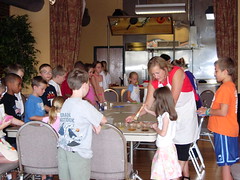"Public" markets and farmers markets and food marketing in DC
Public and farmers markets tend to have public (government) involvement. Technically, a public market is a building like Eastern Market. But for all intents and purposes, the privately owned "DC Farmers Market" and the wholesale and retail food district that surrounds it, "The Florida Market" and the Maine Avenue Seafood Market in Southwest DC are public markets, even though they are privately owned.
Belvedere Square in Baltimore is an upscale privately owned "public" market, but in Baltimore there are six publicly owned markets, including Lexington Market.
I am on the board of Eastern Market. Technically, it is a "community advisory committee." I went on earlier in the year, and the fire and dealing with the aftermath has made me take the responsibility much more seriously.
Last September, I wrote a memo about cultural resources and assets in the city and how they are funded and managed. (See "Cultural resources planning in DC: In the land of the blind, the one-eyed man is king" for the full memo.) In that memo is the suggestion that public and farmers markets be managed together and in one entity.
The Eastern Market legislation creating the management structure and community advisory council calls for a nonprofit entity management structure. But I think the legislation was too parochial in two ways. First, Eastern Market belongs to all of us in the city, not just to the residents of Capitol Hill. Second, there needs to be a broader structure managing and planning for all the markets, not just Eastern Market.
The Central Market in Lancaster Pennsylvania has a "master plan," with 10 goals. In doing the plan, they looked at the organizational structure too, and created the Central Market Trust.
I wonder if a structure like that is in order for DC, but more along the lines of Baltimore. Technically, Baltimore has two separate public markets organizations, the Lexington Market and the Baltimore Public Markets Corporation. But these organizations are consolidating, under the directorship of Casper Genco, who originally managed only the Lexington Market.
Getting back to Lancaster, here are the goals and actions for the Market there:
Action 1: Continue City ownership of the building allied with a new, proactive management structure for business operations
Action 2: Understand, quantify and manage financial issues, resources and opportunities to generate more business
Action 3: Develop a comprehensive and flexible approach to customer needs, standholder mix and product balance to expand the customer base
Action 4: Change ordinances, regulations and leases
Action 5: Ensure appropriate preservation of the 1889 building over the long term
Action 6: Address interior building and system improvements
Action 7: Reinforce and enhance the relationship of the Market House to the surrounding urban areas
Action 8: Support economic development initiatives that strengthen Central Market and the city center
Action 9: Enhance the community’s awareness of this key civic gathering place
Action 10: Continue to invite others to enjoy this unique and historic place
Without setting priorities, it's very difficult to plan. At the same time, it's very difficult to assist the markets in addressing competition.
This comes to mind because of the fact that more and more people are eating prepared foods, or they need to learn how to cook.
If there were a master plan for Eastern Market or Florida Market, these trends could be addressed. E.g., with the recovery of the basement of Eastern Market as a fully usable area, somehow a demonstration kitchen could go into the facility, as exists in places like La Boqueria in Barcelona, or the River Market in Little Rock.
One of the ways to pay for this would be to use the kitchen for cooking training for K-12 students, government food supplement programs (WIC, food stamps, senior nutrition, etc.), and people like me.

Teaching Kitchen, River Market, Little Rock, Arkansas. Photo courtesy Daman Hoffmann.
The Daytona Beach News Journal has a piece about Publix supermarkets, one of the most successful companies in its field, and how it is addressing the rise of the "meal assembly centers" by opening its own. See "Starved for time and a home-cooked meal." From the article:
The Lakeland-based chain will open its first Make-Ahead Meal outlet in the Jacksonville area this fall. The store is an extension of Publix Apron's program, which includes recipes, simple meals and cooking schools, spokesman Dwaine Stevens said. Another pilot store is slated for the Tampa Bay area...
Under Apron's Make-Ahead Meals, customers can register online for a meals-assembly session. At the session, the ready-to-cook ingredients are prepared and ready to assemble. The meals are then built and packaged for customers to freeze and use later. They are seen as a boon to time-starved families as well as those who are just don't feel like cooking. .
For more than one year, I've been suggesting such a site for Florida Market, but there is no reason that one couldn't go into the basement of Eastern Market, and be run "collectively" by the vendors, being supplied with food they provide.
From the article on Publix:
Bill Greer, a spokesman with the Food Marketing Institute, said supermarkets are always looking at ways to remain competitive and to do this, companies pay close attention to consumers.
Greer said prepared foods are one of the high-growth areas for supermarkets. "A lot of people don't know how to cook or don't want to cook," he said in a telephone interview from Washington, D.C.
Supermarkets will do what it takes to hold and attract consumers, he said, be it the introduction of more prepared foods in the deli section or meal assembly programs, which are a faster way to cook.
Shouldn't the Public and Farmers Markets in DC be competitive also?
Labels: food-agriculture-markets



0 Comments:
Post a Comment
<< Home